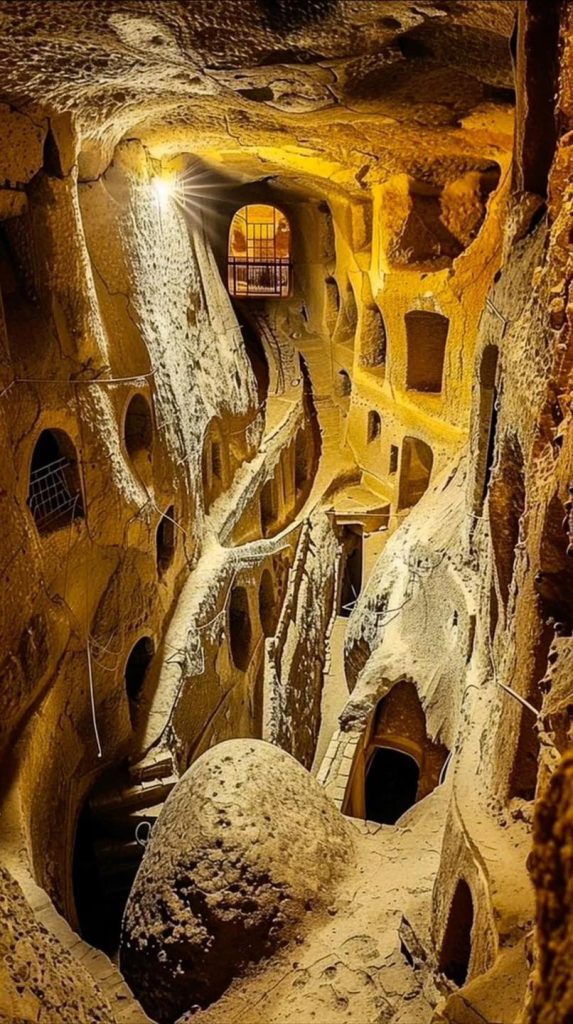Archaeologists have uncovered compelling evidence of an extensive network of underground tunnels spanning from Scotland to Turkey, believed to date back approximately 12,000 years. This extraordinary find has sparked significant interest and led researchers to reconsider the level of connectivity and sophistication among ancient European societies. The existence of such a vast network implies that prehistoric cultures were far more advanced and interconnected than previously assumed, shedding new light on early human history and achievements.
The purpose of these ancient tunnels remains a subject of debate among experts, as their precise function is not yet fully understood. Researchers have proposed several plausible theories to explain why these tunnels were constructed. One theory is that they provided protection from predators and other dangers in the prehistoric landscape, serving as a safe haven for early humans. Another possibility is that they functioned as ancient highways, facilitating travel and trade between different regions across Europe. These tunnels might also have held spiritual or religious significance, potentially acting as sacred pathways or ceremonial spaces.

Dr. Heinrich Kush, a prominent German archaeologist, has extensively studied these tunnels and documented his findings in the book Secrets Of The Underground Door To An Ancient World. According to Dr. Kush, these subterranean passageways have been discovered beneath many Neolithic settlements across Europe, suggesting a shared knowledge or tradition of tunnel construction among ancient cultures. This widespread presence underscores their importance in the lives of early societies and raises intriguing questions about their origins and purposes.
The tunnels themselves exhibit remarkable characteristics that highlight the advanced engineering and architectural skills of their builders. They vary in size, with some passageways measuring over a meter in width, making them wide enough for people to move through comfortably. Additionally, many of these tunnels include chambers and storage areas, which suggest they were used for more than just transportation. Some even feature seating areas and small nooks, indicating that they may have served as places for rest or gatherings. The construction techniques employed in building these tunnels demonstrate a high level of sophistication, with careful attention paid to stability and durability. These features reflect a deep understanding of engineering principles that was uncommon for the era.
Several notable examples of ancient tunnel systems provide further evidence of the advanced capabilities of early civilizations. One of the most impressive is found in Cappadocia, Turkey, where the underground city of Derinkuyu stands as a testament to ancient ingenuity. Carved into soft volcanic stone, Derinkuyu extends multiple levels below the surface and showcases the expertise of its builders in creating a stable and functional subterranean environment. The city includes living quarters, storage areas, ventilation systems, and even areas designated for livestock, demonstrating a comprehensive understanding of underground construction.
Another remarkable example is found in Bosnia, where the so-called Bosnian Pyramids and their extensive tunnel systems highlight the advanced engineering knowledge of ancient peoples. These tunnels not only reveal the technical skill involved in their creation but also suggest a broader cultural significance tied to their use.
The cultural and spiritual importance of these tunnels has also been a topic of exploration. Dr. Kush proposes that some of these tunnels may have been viewed as gateways to the underworld, a concept that is echoed in various ancient writings found within the passageways. The Church is believed to have played a role in shaping perceptions of these tunnels during later periods by building chapels at their entrances, possibly to control access and the narrative surrounding these structures. This association with spirituality and the afterlife adds another layer of mystery and significance to the tunnels, hinting at their role in the belief systems of ancient societies.
The discovery of this extensive tunnel network challenges long-held assumptions about prehistoric civilizations, prompting a reevaluation of their knowledge and technological capabilities. Conventional views often depict early humans as relatively primitive and isolated, yet the existence of these tunnels paints a very different picture. It suggests that ancient societies were capable of impressive feats of engineering and that they may have shared knowledge and resources across vast distances. This revelation compels modern researchers to reconsider the complexity and interconnectedness of early human communities.
Moreover, these tunnels serve as a testament to the resilience and ingenuity of our ancestors. They demonstrate a profound understanding of their environment and the ability to adapt and thrive in challenging conditions. The construction of such an extensive and enduring network would have required significant planning, collaboration, and resources, underscoring the sophistication of these ancient cultures.
The implications of this discovery extend beyond the realm of archaeology, offering valuable insights into the shared heritage and ingenuity of humanity. As researchers continue to study and uncover more about these tunnels, they provide a window into a forgotten world, revealing the rich and complex tapestry of early human history. The story of these tunnels reminds us that even in the distant past, humans possessed a remarkable capacity for innovation and connection, qualities that continue to define our species today.
This vast network of underground tunnels is not only a remarkable engineering achievement but also a profound symbol of the interconnectedness of ancient civilizations. It challenges us to look beyond traditional narratives and embrace a more nuanced understanding of our shared past. By studying these ancient passageways, we gain a deeper appreciation for the ingenuity, adaptability, and creativity of our ancestors, qualities that have shaped the course of human history for millennia.





